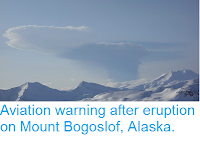The Alasaka Volcano Observatory
issued a warning to aviation following an eruption on Bogoslof Island
in the Aluetian Chain on the morning of Saturday 10 June 2017.
The eruption produced an ash column
which rose to over 9000 m above the uninhabited island. This is the latest in a series of eruptions that began in December last year, many of which have produced ash columns that rose to heights of over 6000 m, the trigger point for aviation warnings in the Aleutian Islands.
Satellite image of an ash column over Bogoslof on 5 June 2017, taken with the Operational Land Imager on the Landsat-8 satellite. NASA.
Bogoslof Island is uninhabited, and the islands around is are home to at
most sparse Human populations, however it still presents a serious
threat to air-traffic, as the Aleutian Islands lie in the path of a
number of commercial aircraft routes, connecting the US to East Asia.
Volcanic ash is extremely hazardous to aircraft in a number of ways. At
its most obvious it is opaque, both visually and to radar. Then it is
abrasive, ash particles physically scour aircraft, damaging components
and frosting windows. However the ash is most dangerous when it is
sucked into jet engines, here the high temperatures can melt the tiny
silica particles, forming volcanic glass which then clogs engine. When
this happens the only hope the aircraft has is to dive sharply, in the
hope that cold air passing through the engine during the descent will
cause the glass to shatter, allowing the engine to be restarted.
Obviously this is a procedure that pilots try to avoid having to
perform.
Bogoslof Island forms the tip of a submarine volcano that rises from the
Bering Sea floor, 1.8 km below the surface. The island only rises 150 m
above the surface, but is 1.76 km in length and 500 m wide, forming
part of the rim of the caldera (crater) of the volcano; all eruptive
activity occurs beneath the surface to the northeast of the island
itself. The nature of the island means that it is frequently reshaped by eruptions.
The approximate location of Bogoslof Island. Google Maps.
The volcanoes of the Alaskan Peninsula and Aleutian Islands are fed by
magma rising from the Pacific Plate, which is being subducted beneath
the North American Plate to the south along the Aleutian Trench. As the
subducting plate sinks into the Earth it is subjected to enormous heat
and pressure, causing more volatile minerals to melt. These then rise
through the overlying North American plate as magma, fuelling the Alaskan
volcanoes.
How the subduction of the Pacific Plate beneath the North American
Plate fuels the volcanoes of Alaska. Alaska Volcano Observatory.
See also...
Follow Sciency Thoughts on Facebook.









